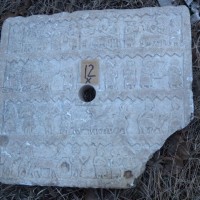
Breakthrough Basalt Analysis by Israeli Archaeologists Generates Surprising Research Results

The Jewish Synagogue, built in the 4th century AD of black basalt stones, Chorazin, Israel. Photo by Carole Raddato, Flickr
In a new study, Israeli researchers have successfully applied chemical analysis to differentiate sources of basalt, a volcanic rock that has historically been challenging to trace due to the absence of a comprehensive comparative database.
Recent advancements in modern analytical techniques have significantly deepened understanding of human history and ancient materials, Israeli newspaper Haaretz writes in a report.
Notably, the utilization of these techniques has illuminated the complex migration patterns of early humans and animals and even traced the origins of various stone and metal artifacts through chemical analysis.
The basalt analysis breakthrough achieved in Israel was detailed in a paper published this year in the journal “Archaeometry” by Dr. Mechael Osband from Kinneret Academic College, Dr. Michael Eisenberg from the Zinman Institute of Archaeology at the University of Haifa, and Prof. Jeffrey Ferguson from the University of Missouri.
The research focused on 96 basaltic structures at two sites in northern Israel: the cliff-top Roman city of Antiochia-Hippos and the inland village of Majduliyya.
These sites provided a unique opportunity to test the new methodology, which relies on X-ray fluorescence (XRF) to analyze the composition of basalt samples.
“We were surprised it worked,” commented Dr. Osband, highlighting the affordability and accessibility of portable XRF analysis compared to other more costly techniques.
This approach allows for the analysis of a larger number of samples, potentially leading to the development of a global database of basalt compositions similar to existing ones for obsidian.
The findings from Hippos and Majduliyya were revealing. Not only were researchers able to distinguish between basalt sourced from different quarries, but they also found that the stone used in both locations were distinctly different, negating the initial hypothesis that they shared a common source.
“Our purpose was to see whether we could receive repeatable chemical fingerprints – if we could reliably say that this stone and this stone came from the same place,” explained Dr. Eisenberg.
The consistent results were a pivotal achievement, providing clear divisions of basaltic structures into three distinct groups.
The study also delved into the socio-economic implications of these findings.
Knowing whether ancient cities sourced their building materials locally or from distant quarries can shed light on their economic capabilities and trade networks.
The implications of the basalt analysis research are evident in the findings at Antiochia-Hippos and Majduliyya.
Both towns were situated within the basalt fields of the Golan, yet their building materials were sourced differently, challenging previous assumptions about resource sharing in ancient communities.
“We wanted to know if the same quarry served the people in the northern Hippos district or not. Answer: completely different,” Dr. Eisenberg explained.
For instance, the differing sources of basalt for Hippos and Majduliyya suggest variations in resource accessibility and possibly in the economic status between the two locations.
Furthermore, the research revealed that the Roman and Eastern Roman (Byzantine) periods in Hippos utilized basalt from different volcanic flows, illustrating a nuanced historical narrative of resource usage over time.
This research not only clarifies the origins and use of basalt in ancient constructions but also enhances our understanding of historical construction practices in regions like Northern Israel, where basalt was a common building material due to the local volcanic landscape.
By improving understanding of material origins and their historical applications, these modern techniques are helping to piece together the vast mosaic of human history, offering insights that were previously unattainable, the report points out.
This evolution in archaeological science highlights the continuous journey of discovery that shapes our understanding of the past, providing a clearer picture of how ancient societies interacted with their natural resources and landscapes, it notes further.
***
DID YOU KNOW that there is now an entire ancient nation made up of archaeologists?
It exists against all odds in “The Mudbrick Swamp,” a fantasy book by Ivan Dikov – Volume 1 of the “Rodiniya’s Reason” fantasy series!
BUY ‘THE MUDBRICK SWAMP,’ Book 1, Volume 1, of the RODINIYA’S REASON fantasy series HERE!












